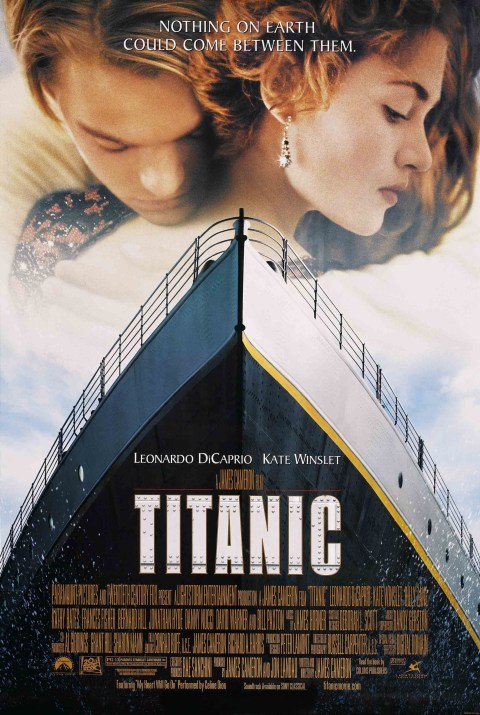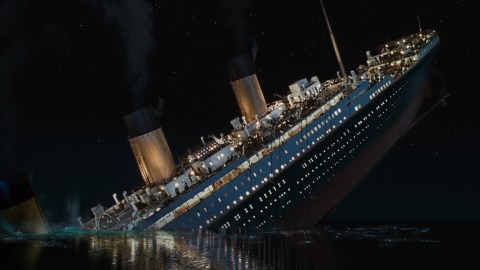17. 4. – 19. 4. 2026
Titanic

 Original title: Titanic
Original title: TitanicDirector: James Cameron
Production: 1997, USA
Length: 194 min.
Screened:
KRRR! 2012: 3D digital , Colours intact, PCM, Spoken language: English, Subtitles: CzechKRRR! 2023: 70mm 2.2:1, Colours intact, DTS, Spoken language: English, Subtitles: Czech, Danish
Annotation for KRRR! 2023
Starting in late 1997, James Cameron's Hollywood blockbuster Titanic captured cinemas around the world with such force that it became the most successful film of all time for twelve long years... before Cameron's next film surpassed it. A romantic story set against the backdrop of historical tragedy, it is still remembered by audiences across generations today. In fact, Cameron likes to bring his films back to the cinema in restored versions, which is why Titanic has been seen on the big screen several times in the twenty-five years since its release, especially in three dimensions. This year in Krnov, however, we get the opportunity to not only revisit it once again, but also in 70 mm format.
In it, James Cameron turns to one of his life's passions, the ocean. This is a motif that has accompanied his film career (and not only), and perhaps most notably integrated into the narrative in his last feature film to date, Avatar: The Way of Water (2022). Despite its undoubted success, however, Cameron's films have not been unreservedly received, and his scripts in particular have been criticised for clichés, one-dimensional characters and superficial storytelling. In contrast, the action and visual effects, which Cameron has pioneered since the 1980s and has been keen on, are regularly praised. Whether it's the realistic animation in the second Terminator (1991), the revolutionary water effects in The Abyss (1989) or pushing performance capture technology to the highest possible level in Avatar (2009) and its sequels.
Despite criticism, however, Titanic went on to win eleven Oscars in 1998, including for Best Director and Best Picture, as well as launching the careers of Leonardo DiCaprio and Kate Winslet in the lead roles to the highest echelons of Hollywood, where they both remain to this day. Thanks to them, too, the love couple of Jack and Rose has become the modern equivalent of Romeo and Juliet. However, as much as the romantic storyline dominates the film and is easily remembered by audiences, James Cameron chose to frame the historical tale in contemporary underwater exploration, making Titanic easily relatable to his previous and subsequent work. Indeed, exploration of the ocean's depths is not only the narrative motif of Titanic and The Abyss, but it was also the focus of his subsequent documentary work, which consumed his career for over a decade before the ambitious science fiction of Avatar.
Annotation for KRRR! 2012
The name of perhaps the most famous ship in human history became a symbol of tragedy in 1912, which somewhat contrasted with the original visions of the builders, investors and, ultimately, passengers, for whom the Titanic represented above all the personification of human triumph. Titanic thus managed to triumph in every way only 85 years later, when James Cameron made a film about it, which dominated the attendance charts for many weeks, until it finally ended up as the most commercially successful title in film history. In addition to the unequivocally enthusiastic critical response and a number of other awards, Titanic equaled both long-standing Oscar records, both in the number of fourteen nominations and the number of eleven gold statuettes won, thus figuratively standing alongside Wyler's Ben Hur.
When Cameron declared himself "king of the world" at the Oscars, in the words of the hero of his film, he certainly had no reason to regret the production hardships he had endured with the "unsinkable" ship. The exceeded shooting time, the incredibly increased budget, the postponement of the premiere date from summer to before Christmas, and Cameron's return of his fee all indicated that the film would follow the fate of the ship it tells about. Titanic certainly did not promise Fox any profitable merchandising or a possible sequel. The construction of new studios on the coast of Mexico alone, necessary for filming the scenes of the ship's sinking, or rather its ninety percent model, cost forty million dollars. For Cameron, the project was very personal and he made sure that he had full control over it from start to finish as director, producer, screenwriter, and editor. Knowing that no one in the audience would go to the film without knowing "how it would probably turn out", he adapted the structure of the narrative to the audience's knowledge. The first twenty minutes of the film follow the current search in the wreck of the Titanic, during which a computer simulation of its sinking is also very clearly demonstrated. Only then does the appropriately narrative historical story take the stage, which is conveyed to contemporaries (on the screen and in the cinema audience) by a more than century-old witness to that fateful night from April 14 to 15, 1912. She is also the protagonist of a love (melo)drama that begins, culminates and ends, almost according to the laws of the tragedy on the Titanic. The social differences between the two main characters (she is a rich young lady from first class, he is traveling in third class and won the ship's ticket at cards five minutes before departure) not only build the basis for a dramatic conflict, but also allow for the maximum display of the ship's environment. Moreover, Cameron skillfully inserts real situations, people and events from the voyage into the fictional love story, so that the viewer can orient themselves and become emotionally involved in the catastrophic part of the film.
There is certainly much more that could be written about Titanic. About the "Leonardomania", which for a while overshadowed the acting skills of the leading male role, Leonardo DiCaprio. About the previous adaptations of the tragedy of the "unsinkable ship" and its fifteen hundred victims, the most famous of which is the British The Sinking of the Titanic from 1958, the first of which was created just a few weeks after the tragedy on her own initiative and with one of the survivors in the lead role. However, it is highly likely that Titanic will be written about again, because after the triumph of Avatar and on the wave of 3D conversions, James Cameron is coming as a modern pioneer of this format to return Titanic to cinema screens in a new, more plastic form. Moreover, given the centennial of the never-completed voyage, he couldn't have found a more perfect timing for the renewed premiere.